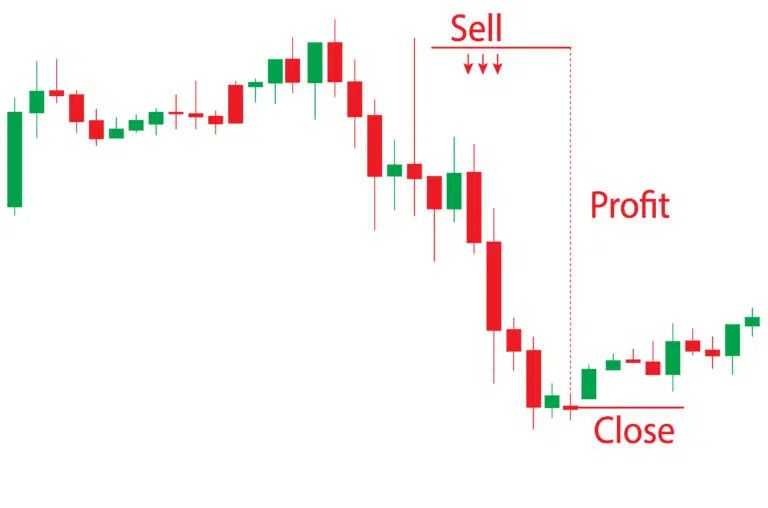Crypto Shorting: Profit During Crashes and Retracements

MORITZ PUTZHAMMER
29 November 2022 • 10 min read

Table of contents
The bad news is that market crashes—whether crypto or otherwise—are inevitable. And, as many traders can attest, they can wreak havoc on even the most resilient portfolios. A crypto winter, for example, can last well into the spring and summer months. And if you’ve decided to hibernate and wait it out by HODLing, then you’re bound to take some significant hits to your portfolio, at least in the short term until the market recovers and enters a new cycle.
During a crypto crash, most investors typically opt to “buy the dip,” which is otherwise known as the “catching a falling knife” strategy. The obvious problem is that you never know how low the dip will go, making it quite challenging to identify the absolute bottom of the dip. It’s also a passive trading strategy; you’re simply waiting for the market to turn around rather than actively leveraging opportunities for profit.
Are crashes and all doom and gloom, then? Can savvy traders spot opportunities to take profit even under the most challenging of market conditions? One way to beat a bear market is through crypto shorting, which is different from margin trading with leverage.
In the following article, we’ll look into crypto shorting—its many advantages as well as a few of its disadvantages along with the best exchanges to short crypto. Let’s get to it!
What Causes Crypto Market Crashes?
First things first—what actually causes the crypto market to crash? Effectively, there are two primary causes of crypto market crashes: 1) the collapse of major players in the crypto ecosystem and 2) interest rate hikes in centralized finance.
Crypto collapses and crypto contagion
The collapse of major crypto exchanges or projects often has a domino effect across the entire industry, causing FUD among many traders.
Most market crashes are precipitated by a liquidity crunch in the market after the collapse of a major crypto exchange or project. Recent examples of this are the collapse of Terra Luna in May and the implosion of centralized crypto exchange FTX in November 2022. In the case of Terra Luna, a bear run wiped out about $6 billion in less than two weeks, while approximately $230 billion was wiped from the crypto market in just six days in the case of Samuel Bankman-Fried’s FTX scandal.
As we’ve seen in the case of FTX, subsequent aftershocks can result in further market instability. Hong Kong-based cryptocurrency exchange Genesis Block had to cease trading as a direct result of the FTX fiasco.
Interest rate hikes
Since its inception, crypto has been touted as an alternative to centralized finance. But interest rate hikes coupled with inflation reduction measures make centralized finance relatively attractive, particularly for institutional and high net-worth investors who see it as a haven. In such cases, capital tends to flow from the crypto market to fiat investments, or simply remains in the fiat market in the first place.
Capital flight, especially by whales, can often be seen as a form of signaling to retail investors, who in turn sell their crypto holdings (the classic domino effect). It’s crucial to remember that market sentiment plays an important role when it comes to price fluctuations in the crypto market. Consequently, crypto investors tend to flee from what they think are risky assets when market sentiment sours.
Compounding this is the fact that the crypto market doesn’t have circuit breakers like the stock market. If the price of a share drops by 10% in a day, its trading is halted, thereby avoiding a worst-case-scenario situation. Conversely, a persistent synchronized selloff could lead to crypto market flash crashes.
What is Crypto Shorting?
Now that we know some of the primary causes of crypto market crashes and retracements, let’s explore crypto shorting. The underlying idea behind crypto shorting is an anticipated fall in an asset’s price. You’re essentially betting against it. If you’ve seen Netflix’s documentary “Eat the Rich: The GameStop Saga,” then you’ll already know quite a bit about shorting.
The same principle applies to crypto. If you think that the value (and thus the price) of a particular crypto is going to drop, then you might consider borrowing and subsequently selling it—buy high and sell low. And this can be done in a number of ways, such as trading on margin, buying futures or options, or by using something called contract for difference (CFD).
During a crypto market crash, the primary goal of crypto shorting is to sell when the price is higher with the intent to buy back after the price drops. In other words, it is the opposite of going long in which you expect prices to rise, and thus buy crypto in the hope of selling at a higher price. But during a crypto market crash, crypto prices are in a steep decline, meaning the best way to profit is to trade in the direction of the market trend.

One key thing to note about crypto shorting is that you don’t actually own the crypto you short. You have to borrow them from your crypto exchange and will naturally incur interest charges for the service.
How Does Crypto Shorting Work?
Let’s say we’re in a crypto market crash, and you want to short ETH during this period. You borrow ETH from your trading intermediary, say 1 ETH, and sell it at the prevailing market price. For simplicity, let’s assume the prevailing market price of 1 ETH is $1,500. Now, since it’s a market crash, the price falls to, say, $1000. So, you buy back ETH at $1,000 and return it to your broker or exchange. In this case, you’ve made a profit of $500 minus any additional charges you may incur, including interest.
As deceptively simple as all of this sounds, traders should note that it’s an advanced strategy, one requiring a deep knowledge of markets and trading fundamentals. Gains can accumulate quickly, but so, too, can losses, which brings us to some of the risks and rewards of this popular trading strategy.
What are the Risks and Rewards of Crypto Shorting?
We now know that crypto shorting allows you to profit during market crashes. It also allows you to capitalize on short-term market volatility and hedge your portfolio against potential market downturns. But it isn’t without risks. Here are the advantages and disadvantages of crypto shorting.
Advantages of crypto shorting
- Shorting allows you to take advantage of market volatility. Crypto markets are inherently volatile, and shorting enables you to capitalize on short- and long-term bullish and bearish trends.
- Allows you to hedge and protect your crypto portfolio during a bear market. Say you already HODL $10,000 worth of BTC and you believe that a bear market is just around the corner. In this case, you short bitcoin and if the prices drop, the profits from the short sell should cover any depreciation in your portfolio, or significantly reduce the losses.
Disadvantages of crypto shorting
- Potential limitless losses. The same volatility that makes crypto shorting attractive also makes it risky. When you buy crypto, you can hold it for as long as you want. Even when the price drops, it will never reach zero. When shorting, however, a bullish spike followed by a sustained uptrend could push the losses beyond your initial investment, especially if you don’t have a stop-loss order in place.
- When short-selling, you’ll incur margin interest. Short selling usually involves borrowing crypto from your exchange, and this comes at a price. You’ll incur interest on the borrowed cryptos for as long as you hold them. This eats into your profits or increases your losses if the market goes against you.
How to Short Crypto Profitably
The example we’ve given above is the basic principle of crypto shorting. However, different trading platforms have different ways in which you can short crypto, and these usually involve crypto derivatives. Crypto derivatives include crypto CFDs, crypto futures, and options. When trading derivatives, you can use margin and leverage, which allow you to open significantly larger positions compared to the capital you have. However, you must first deposit your initial capital into your trading account to access margin trading and leverage facilities from your crypto exchange. Below are some of the practical ways you can short crypto.
Shorting crypto CFDs (Contracts for Difference)
A crypto contract for difference (CFD) allows you to speculate on a crypto price without owning the underlying crypto. It’s a type of derivative that serves as a contract between a trader and a broker or crypto exchange.
Shorting a crypto CFD means that you are banking on the price of the underlying crypto to drop, in which case your position closes at a profit. Note that your position will remain open until you manually close it or if it hits your stop loss or profit target. You’ll be closed out if the price of the crypto rises and the losses incurred exceed the amount of capital you have in your trading account.
Shorting crypto futures market
A futures contract is an agreement between two parties to buy or sell an asset at a predetermined future date and price. A crypto futures contract tracks the price of the underlying crypto, making it ideal for speculating on the future price of a given cryptocurrency.
When you buy a crypto futures contract, you expect that the price will increase. On the other hand, selling futures contracts means you expect the price of the underlying crypto to drop. In this case, you can short the crypto market by entering into a futures contract that bets on the price dropping in futures. When the contract expires, the transaction is settled and the contract is closed.
For crypto futures, you can use standard futures contracts, perpetual contracts, or futures. Perpetual crypto futures have no expiry date, and they trade close to the crypto’s price on the spot market. Its primary pricing mechanism is made possible through the funding rate.
Crypto put options
A crypto option is a type of derivative that gives you the right to either buy or sell a specified amount of particular crypto in the future for a specific price. As such, if you want to short a particular crypto, you can use put options. A put option contract allows you to sell your portfolio at a specific price even if the future market price is significantly lower than the current price.
For example, let’s say the current price of BTC is $21,000, and you’ve done your analysis and believe that it’s going to drop in the coming weeks. You can buy a put option, which allows you to sell BTC in, say three weeks, at the current price of $21,000. If the value of BTC drops to, say $16,000, in three weeks when the option expires, you earn a profit of $4,000 minus the contract fees. Note that if the price of the underlying crypto goes up, you will only lose the option premium—the fees paid to hold the options contract.
Prediction markets
Crypto prediction markets allow you to bet on the outcome of particular events. To short crypto in prediction markets, you must predict that a specific coin will drop by a certain amount of percentage. Also, another person, or a counterparty, must take you up on the bet. And for you to receive the payout, the crypto must fall by at least the specified amount or percentage. Otherwise, you lose the wager.
Crypto Shorting Strategies
Now that you know how crypto shorting works, let’s see which methodologies you can employ to effectively short the crypto market.
Sentiment analysis
One thing about which you can be certain is that the crypto market is moved by investors' and traders’ sentiments. Unlike fundamental and technical analysis, sentiment analysis doesn’t rely on quantifiable metrics. It encompasses psychological aspects such as fear of missing out (FOMO), and fear, uncertainty, and doubt (FUD). Usually,although not always, news reports can play an oversized role in creating crypto market contagion. Two words: Luna and FTX (well, okay, that was technically three).
Technical analysis
Technical analysis and fundamental analysis are two sides of the same coin. More precisely, technical analysis involves examining a crypto’s historical price and trends in order to attempt to determine its possible future trends.

It’s based on key principles, which hold that price action is not random and that the market fluctuates in a discernible and predictable manner. And that means we can always expect that historical trends will repeat themselves, particularly since crypto markets are cyclical. For the curious: there are hundreds of technical analysis indicators that can be used to determine the onset of a bear market.
Fundamental analysis
Fundamental analysis helps determine the intrinsic value of a cryptocurrency. It encompasses every other qualitative aspect of cryptocurrency and its blockchain. Generally, fundamental analysis requires a bit of expertise and thorough due diligence since it involves the analysis of a variety of intrinsic and extrinsic factors. Ideally, crypto fundamental analysis revolves around the analysis of three main metrics: fiscal metrics, on-chain metrics, and project metrics.
Best Exchanges for Shorting Crypto
Virtually all of the top crypto exchanges support crypto shorting, and the following are some of the best options.
Binance
Binance is the largest crypto exchange and one of the most trusted in the world. You can short crypto through margin trading, futures trading, shorting Binance Leveraged Tokens (BLVTs), or with options contracts. You can trade with isolated or cross margin and switch between them as well as short USDS-M futures contracts and USDS-M futures contracts.
For a deep dive into Binance and how you can trade profitably on the exchange, check out our in-depth review of Binance as well as our comprehensive guide to creating a Binance crypto trading bot.
Bybit
Bybit is one of the best derivative exchanges. You can short the crypto market with USDC/USDT options and perpetual contracts as well as inverse contracts. You can also short the crypto spot market with leveraged tokens.
OKX
OKX is the third largest crypto exchange in terms of derivatives trading, and you can short cryptos through contracts and margin trading. It offers perpetual swaps, futures, and options.
Final Thoughts on Crypto Shorting
There never seems to be a shortage of clickbait news stories about how a crypto crash has wiped out billions of dollars from the market. And a perennial favorite is the death of Bitcoin. For those of you keeping score at home, BTC has now died some 466 times (and counting). And yet crypto keeps on keepin’ on.
The necessary questions follow: can you short crypto and can you profit from it, particularly during market crashes? As we’ve seen in the above article, the answer is a definitive “yes!” You can indeed profit during market crashes through crypto shorting, but it takes a fair amount of skill, research, and expertise (anything worthwhile always does).
Throughout this guide, we’ve discussed some of the ways that traders profit during market crashes with crypto shorting along with some of the strategies that they use to do so. We’ve also highlighted a number of exchanges for shorting, with Biance being the best and safest option for most people (in our humble opinion).
Nevertheless, while shorting crypto is a great way to profit during market crashes, it’s not without its risks, which is why it’s so important to always do your own research and never risk more than you can afford to lose.





